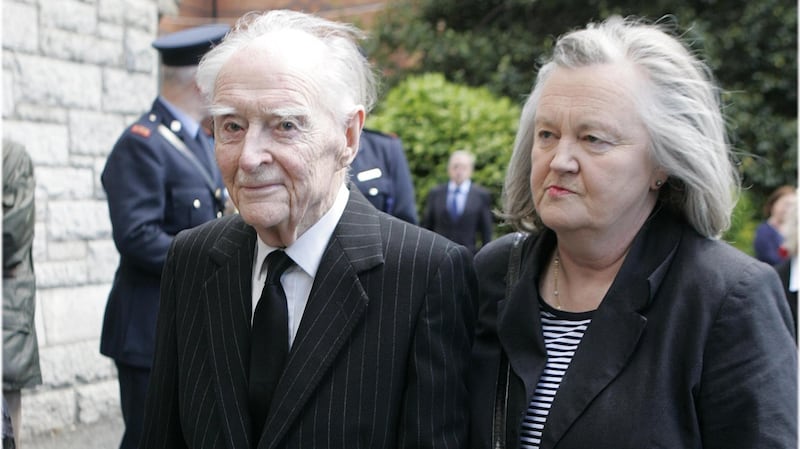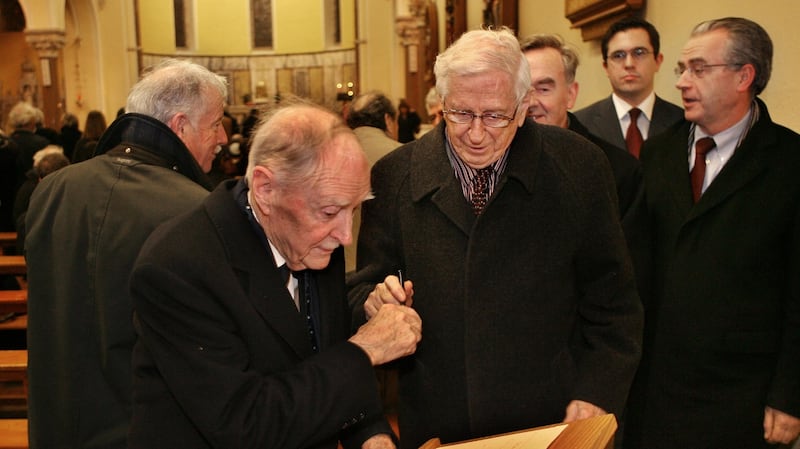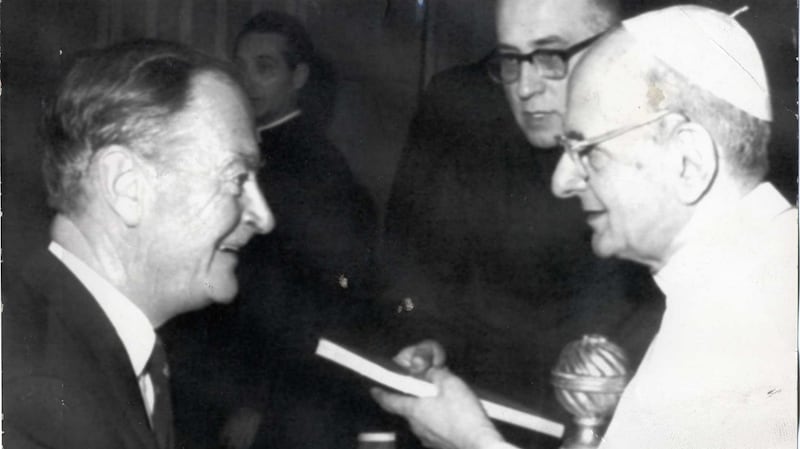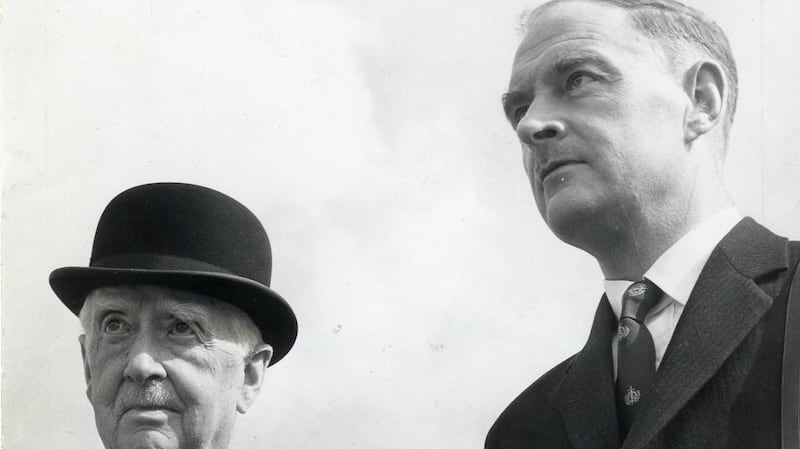Former taoiseach and Fine Gael leader Liam Cosgrave has died aged 97.
Mr Cosgrave led the Fine Gael-Labour coalition Government which ended 16 years of Fianna Fáil domination in 1973, but its unexpected defeat four years later brought his own political career prematurely to an end.
His father, WT Cosgrave, had presided over successive Cumann na nGaedheal governments for 11 years so it was a disappointment to Liam that his stay in power was cut so short.
0 of 4
The size of the Fianna Fáil victory in 1977 was so sweeping that Liam Cosgrave probably foresaw a long period in the wilderness for Fine Gael under his leadership. He was also aware that he would face a serious challenge as leader from rivals, including Garret FitzGerald, for the mis-timing of the election and the poor campaign.
He stood down with an enhanced reputation, however, for personal integrity and for the firmness with which he guided the national coalition through a very difficult period marked by serious threats to the economy from the oil crisis and to national security from the IRA. He was also admired for the fairness with which he treated the Labour ministers in the “Cabinet of all the talents” as it was dubbed. The smooth working relationship between the coalition partners contrasted with the tensions that characterised later coalitions in the 1980s and 1990s.
He will also be remembered, however, for how he wrong-footed his Cabinet colleagues by concealing his intention to vote against the Bill to legalise the import and sale of artificial contraceptives. The Bill, to implement a Supreme Court judgment, had been approved by the Cabinet but with the proviso that a free vote would be allowed in the Dáil. While Cosgrave was thus entitled to vote against the Bill, which limited the sale of contraceptives to married couples and on prescription only, his action according to the then minister for foreign affairs, Garret FitzGerald, "damaged the standing of the Government".
Long career
Although Liam Cosgrave was only 57 when he resigned as leader of Fine Gael he already had a long career in national politics going back to 1943 when he was first elected to the Dáil at the age of 23. He had also served in two previous coalition governments as a parliamentary secretary and as Minister for External Relations.
Liam Cosgrave was born in Dublin on April 13th, 1920 while his father, William, was serving one of his periods in prison for his active role in Sinn Féin. The older Cosgrave had been among the first members of Sinn Féin when it was founded in 1905 and he later joined the Irish Volunteers. His father was a publican and grocer on James’s Street, whose family had roots in Co Wexford and claimed an ancestor in the 1798 Rising.
William Cosgrave had been sentenced to death for his part in the 1916 Rising in which he fought as an officer but was reprieved and transferred to prison in Britain. He was released in 1917 and won a byelection in Kilkenny in that year. He later became a member of the first Dáil in 1919 and was appointed as Minister for Local Government. He had a low-key role in the War of Independence but suddenly found himself heading the Free State Provisional Government following the deaths in August 1921 of Arthur Griffith and Michael Collins.
Liam grew up during a turbulent period while his father and his colleagues in government struggled with the effects of the disastrous Civil War. It was little wonder that for the rest of his life, the security of the State and its institutions would be sacrosanct whenever threatened.
He went to school at the Christian Brothers, Synge Street and later was a boarder at Castleknock College. At 17 he joined Fine Gael and campaigned beside his father in the 1937 election. He studied law at UCD but interrupted his studies to join the Army in 1940 following the declaration of the Emergency. His father had joined his bitter political rival, Éamon de Valera, at a recruiting rally in College Green, appealing to young men to join the Defence Forces to defend Irish neutrality. Liam joined up as a private but was later commissioned as a lieutenant. He was also allowed to continue his law studies and was called to the Bar in 1943.

In the general election of that year he was elected as a Fine Gael TD for Dublin County and joined his father in the Dáil. The latter, who is said to have advised his son not to enter politics, lost his seat in the election the following year but Liam was re-elected and appointed to the party front bench by the new leader Richard Mulcahy. For the 1948 election Cosgrave switched to the new Dún Laoghaire-Rathdown constituency where he topped the poll and continued to do so until he retired in 1981. Although he never lived in the constituency but in the family home in Templeogue, he was assiduous in attending to constituency matters.
Following the 1948 election, Fine Gael formed part of an unwieldy coalition of five parties and Independents to keep Fianna Fáil out of power. Cosgrave was appointed a parliamentary secretary to the new taoiseach, John A Costello. This entailed acting as secretary to the government and attending Cabinet meetings to take minutes. He was also chief whip and parliamentary secretary to the Minister for Industry and Commerce, Dan Morrissey. These were three demanding posts in an unstable government. Cosgrave also had to replace Morrissey when he was frequently ill. He was involved in Anglo-Irish trade negotiations and in talks with the Northern Ireland government over cross-Border projects such as the Foyle Fisheries.
In 1950, he married Vera Osborne from a Co Kildare family noted for horse breeding and racing. Liam shared this passion for horses and loved to hunt and attend race meetings. They had three children, Mary, Liam and Ciaran.
Promotion
Fine Gael was back in power in coalition with Labour in 1954 and Cosgrave was promoted to minister for external affairs. Ireland was admitted to the United Nations in 1955 so he led the Irish delegation that took its seat for the first time in 1956, the year of Suez and the Hungary uprising against Soviet rule. Conor Cruise O'Brien was at that time a senior member of the delegation. Looking back in 1969 he described Cosgrave as "a cautious and rather gentle conservative personality who was known to dislike the school of oratory that he called 'dying for Ireland'." Later, as a minister under Cosgrave in 1973-77, O'Brien would revise his view and admire the toughness he showed under IRA pressure.
Cosgrave’s time handling Ireland’s foreign relations was brief and he attended only one session of the UN General Assembly, but he laid down the three principles which would guide Ireland’s stance there. These were: first, a scrupulous fidelity to the obligations of the UN Charter; second, a position of independence and to “avoid becoming associated with particular blocs or groups as far as possible”; and third, “to support wherever possible those powers principally responsible for the defence of the free world in their resistance to the spread of Communist power and influence.”
By 1957, Cosgrave was back in opposition but he hardly thought that it would be another 16 years before Fine Gael would taste power again. He became a Senior Counsel at the Bar in 1958.
In 1959, Mulcahy, who had been leading Fine Gael from outside the Dáil, decided to stand down. James Dillon, a founder member of the party, was seen as a natural successor but to the surprise of many, Cosgrave also contested the leadership. He explained later that it was right that Dillon, whose father was the leader of the old Irish Parliamentary Party, should be opposed by a member who represented the Sinn Féin tradition. Dillon won, but the size of his majority was never revealed. Beside the colourful Dillon whose oratory could enthral Leinster House, Cosgrave would have been seen as a somewhat uninspiring if effective politician.

It was an interesting development in his political philosophy that Cosgrave went on to support the social democrat "Just Society" principles which Declan Costello promoted in the early 1960s. The party adopted them for the 1965 election but they won no extra seats for Fine Gael which now faced another period of opposition. Soon after the election, Dillon announced that he was standing down. This time Liam Cosgrave was elected leader unopposed when he was proposed by Gerard Sweetman who was then a powerful figure on the front bench.
Garret FitzGerald was elected to the Seanad and Cosgrave appointed him to his front bench. Asked if Fine Gael was now becoming a left-wing party, Cosgrave replied cryptically “A bird never flew on one wing.” He and FitzGerald worked well together at first.
There was a boost for Fine Gael in 1966 when the party's presidential candidate, Tom O'Higgins, was only narrowly defeated by the incumbent, Éamon de Valera. In The Cosgrave Legacy, Stephen Collins writes: "The good relationship between Cosgrave and FitzGerald deteriorated after the presidential election and while an open breach was avoided it got progressively worse in the years that followed."
The dissatisfaction with Cosgrave on the liberal wing of the party increased after Fine Gael's disappointing performance in the 1969 general election. Labour on an anti-coalition platform had hoped to capitalise on the mood of revolt which had swept much of the western world in 1968. Instead, Fianna Fáil under Jack Lynch was returned to office but this time with an overall majority. Fine Gael won only three extra seats.
Mutterings
Cosgrave was certainly aware of the mutterings against his leadership among some of his frontbenchers but attention soon switched to the upheaval within Fianna Fáil when the so-called Arms Crisis broke in May 1970. Cosgrave had received two tip-offs from Garda sources about the plot to import arms involving several ministers but was at first unsure how to handle the evidence. After an unsuccessful attempt to give the Sunday Independent a major scoop, he consulted his colleagues and then went to Lynch who had been hoping to smooth over the affair within his divided Cabinet but now had to be seen to act.
After Lynch sacked Charles Haughey and Neil Blaney and the subsequent arms trial, Fine Gael and Labour opened exploratory talks about a future coalition. Cosgrave was not directly involved as he preferred to delegate such matters while keeping a close eye on the essentials. There were reports that Labour would find Cosgrave unacceptable as the leader of a future coalition but this was put down as wishful thinking on the part of dissidents in his own party whom Cosgrave had notoriously described as "mongrel foxes". A more serious challenge to his leadership surged at the end of 1972.
The Fianna Fáil government was cracking down on a resurgent IRA with a Bill to set up a non-jury court for serious offences and to allow for the conviction of persons for IRA membership on the word of a senior Garda officer. The “liberal” members on the Fine Gael front bench opposed the changes and appeared to have the backing of the parliamentary party as well. Cosgrave, true to his deep-seated instincts, wanted to support the Fianna Fáil Bill and reluctantly went along with the decision of the party to oppose it on the Second Reading. But when he made his speech supposedly supporting the Fine Gael amendment, it was clear that he was still in favour of the proposed measures.
As the time for the crucial vote drew near, Cosgrave appeared isolated from his party and by supporting the government would be in an untenable position. But late in the evening of December 1st, two bombs, presumed to have been planted by loyalist paramilitaries, exploded in central Dublin killing two CIÉ workers. The mood in Leinster House and above all in Fine Gael changed abruptly and the party ended up voting for the increased security powers.
It had been a near thing for Cosgrave, yet within several months he found himself taoiseach and heading a Fine Gael-Labour “National Coalition”. Jack Lynch had called an election early in February 1973 hoping to cash in on the perceived disarray in Fine Gael. But instead the election galvanised the two opposition parties to hammer out a common platform and thus offer the electorate an alternative government and an opportunity to oust Fianna Fáil after 16 years of unbroken power.

Only Cosgrave and the Labour leader, Brendan Corish, had Cabinet experience. The two men quickly established a good working relationship which deepened with time. Cosgrave was generous in the allocation of Cabinet seats and this won him the respect of his junior partners. But the first year was a difficult one. The quadrupling of the oil price put strain on the public finances, the beef market slumped in spite of EEC entry and Northern Ireland devolution plans demanded constant attention.
Power-sharing
Cosgrave headed the large Irish government delegation at the Sunningdale talks which resulted in agreement on a Council of Ireland to accompany the power-sharing system inside Northern Ireland between unionists and nationalists. Cosgrave and the unionist leader, Brian Faulkner, shared an interest in hunting and horses and hit it off well. But six months later the historic power-sharing Executive collapsed in face of the loyalist workers'strike.
IRA prison escapes, gun-runnings, murders, the kidnapping of Dutch industrialist, Tiede Herrema, the assassination of the British ambassador, Sir Christopher Ewart Biggs and loyalist bombs in Dublin and Monaghan posed serious threats to national security. Cosgrave did not flinch in taking the tough decisions necessary. But this toughness may have contributed to his clumsiness when his Minister for Defence, Paddy Donegan, provoked a constitutional crisis.
In October 1976, Donegan criticised President Cearbhall Ó Dálaigh as a "thundering disgrace" for referring to the Supreme Court a Bill which increased the period Gardai could hold terrorist suspects. Donegan offered to resign when his comment leaked out but Cosgrave refused to accept it thus bringing about the resignation of the President. It was felt that Cosgrave had been over-protective of his friend Donegan and that he should have been able to avoid the crisis. It was resolved when Dr Patrick Hillery accepted the invitation to stand unopposed for the Presidency. Some wondered if Cosgrave had deliberately manoeuvred to ensure that Hillery would not succeed Lynch as leader of Fianna Fáil before the next election.
It was obvious an election would be called some time in 1977, most likely June or October. After consultations with his ministers, Cosgrave opted for June but he had taken his experienced eye off the ball. He over-estimated the Coalition's popularity, under-estimated Fianna Fáil's state of readiness and probably was too complacent about the electoral advantage arising from the so-called "Tullymander". This was a re-drawing of the constituencies which was supposed to work in favour of Fine Gael and Labour. In fact the swing to Fianna Fáil was such that the Coalition lost more seats than they would have under the old system. It was a rout. Fianna Fáil returned with its biggest majority in its history while prominent Coalition ministers such as Conor Cruise O'Brien, Patrick Cooney and Justin Keating lost their seats.

Cosgrave knew the knives would be out for him within Fine Gael once the dust had settled. He decided not to wait and announced his resignation as leader a week after the election. He had time before the new government was elected to appoint a number of Fine Gael supporters to judgeships and other state vacancies.
The historian, JJ Lee, has written that Liam Cosgrave was “essentially a local politician operating at national level, and operating, by the standards of local politics, very effectively. He played the patronage game with unconcealed satisfaction.” Supporters of Cosgrave saw him as doing the decent thing and fixing up people who would otherwise suffer economically from the change of government.
He led a very private life during his long retirement, rarely appearing at public functions and never commenting on political matters. His wife, Vera, died in 2016; he is survived by their daughter, Mary; and sons, Liam and Ciarán.












